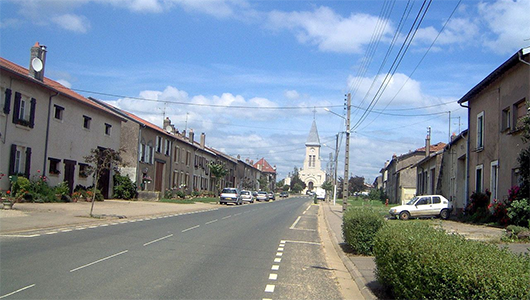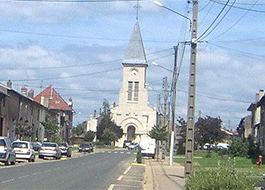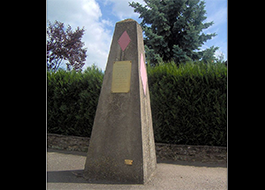Viéville-en-Haye
Durée visite : 20 minutes
Moyen : Pédestre
En 1126, le duc de Lorraine Simon 1er fonde ici l’abbaye de Sainte-Marie-aux-Bois. Elle sera transférée à Pont-à-Mousson en 1607. Les habitants devaient fournir une garnison pour le château de Prény. Ce n’était pas de tout repos. En 1429, les Messins en guerre contre le Duc ravagèrent Viéville. L’abbé de Sainte-Marie fit appel à des colons pour repeupler le hameau. Les heureux arrivants purent ainsi être soumis aux dîmes et rentes dues à l’abbaye. Bis répétita; le village est à nouveau détruit par les Suédois vers 1635 et en 1914-18 par les Allemands.
In 1126, the Duke of Lorraine Simon I founded the abbey of Sainte-Marie-aux-Bois here. She was transferred to Pont-à-Mousson in 1607. The inhabitants were to provide a garrison for The Castle of Prény. It was not easy. In 1429, the Messins at war with the Duke ravaged Viéville. The abbot of Sainte-Marie called on settlers to repopulate the hamlet. The lucky arrivals were thus able to be subjected to the tithes and rents due to the abbey. Bis repeated; the village was again destroyed by the Swedes around 1635 and in 1914-18 by the Germans.
1126 gründete der Herzog von Lothringen Simon 1. hier die Abtei Sainte-Marie-aux-Bois. Sie wird 1607 nach Pont-à-Mousson verlegt. Die Bewohner sollten eine Garnison für das Schloss Preny liefern. Das war nicht einfach. Im Jahr 1429 zerstörten die Messiner im Krieg gegen den Herzog Viéville. Der Abt von Sainte-Marie setzte Kolonisten ein, um den Weiler wieder zu bevölkern. So konnten die glücklichen Ankömmlinge den Zehnten und Renten unterworfen werden, die der Abtei zustehen. Bis wiederholte; wird das Dorf wieder von den Schweden um 1635 und in 1914-18 von den Deutschen zerstört.

D’argent à sept tourteaux de sinople mis en orle, entourant un écusson d’azur chargé d’un M antique d’or accompagné de trois étoiles à six branches de même.
L’abbé de Sainte Marie aux Bois était seigneur du lieu, d’où les armes de l’abbaye : Un M et trois étoiles. En 1738, les habitants de Viéville ont déclaré posséder sept cantons de bois différents ; ceux-ci sont représentés par les sept tourteaux (ronds) de sinople. Ce blason communal est utilisé depuis 1982.
Argent with seven cakes Vert set in orle, surrounding an escutcheon Azure charged with an antique M Or accompanied by three six-pointed stars of the same.
The abbot of Sainte Marie aux Bois was lord of the place, hence the arms of the abbey: An M and three stars. In 1738, the inhabitants of Viéville declared that they had seven different wooden cantons; these are represented by the seven (round) cakes of vert. This municipal coat of arms has been in use since 1982.
Argent mit sieben Kuchen Vert in Orle, umgeben von einem Schild Azure, das mit einem antiken M beladen ist. Oder begleitet von drei sechszackigen Sternen desselben.
Der Abt von Sainte Marie aux Bois war Herr des Ortes, daher die Arme der Abtei: Ein M und drei Sterne. 1738 erklärten die Einwohner von Viéville, sie hätten sieben verschiedene Holzkantone; diese werden durch die sieben (runden) Kuchen von vert dargestellt. Dieses städtische Wappen wird seit 1982 verwendet.

Les habitants de Viéville-en-Haye s’appellent les Viévillois et les Viévilloises.
The inhabitants of Viéville-en-Haye are called the Viévillois and the Viévilloises.
Die Einwohner von Viéville-en-Haye heißen Viévillois und Viévilloises.
Les points de visites
.
L’église Saint-Airy est construite en 1920. Quelques mots sur ce saint peu connu. Airy ou Agericus a vécu au VIe siècle. Il fut le 10e évêque de Verdun, où il repose dans la cathédrale. Né dans un champ, d’où son nom latin qui signifie champêtre, il est le filleul du roi Thierry Ier, fils aîné de Clovis. Il est représenté avec un tonneau. Car, au cours d’un festin à la cour d’Austrasie, le vin vint à manquer. Airy bénit alors le dernier baril, et le divin liquide coula à flot, meilleur qu’auparavant. Reconnaissant, Childebert II donna des terres à l’évêché.
The Saint-Airy church was built in 1920. A few words about this little-known saint. Airy or Agericus lived in the 6th century. He was the 10th bishop of Verdun, where he rests in the cathedral. Born in a field, hence his Latin name which means rural, he is the godson of King Thierry I, eldest son of Clovis. He is represented with a barrel. For, during a feast at the court of Austrasia, wine ran out. Airy then blessed the last barrel, and the divine liquid flowed, better than before. Grateful, Childebert II gave land to the bishopric.
Die Saint-Airy-Kirche wurde 1920 erbaut. Ein paar Worte zu diesem wenig bekannten Heiligen.Airy oder Agericus lebten im 6. Jahrhundert. Er war der 10. Bischof von Verdun, wo er in der Kathedrale ruht. Er wurde auf einem Feld geboren, daher sein lateinischer Name, der ländlich bedeutet. Er ist der Patensohn von König Thierry I., dem ältesten Sohn von Clovis. Er ist mit einem Fass vertreten. Denn während eines Festes am Hof von Austrasien ging der Wein aus. Airy segnete dann das letzte Fass und die göttliche Flüssigkeit floss besser als zuvor. Dankbar gab Childebert II. Dem Bistum Land.
.
.
La 5e U.S. division fut activée le 1er décembre 1917, à fort Logan, près de Houston au Texas. Elle arriva en France le 1er mai 1918. Le 28 août la 5e division reçoit l’ordre d’intégrer la 1re armée américaine. Celle-ci doit réduire le saillant de Saint-Mihiel, qui forme une hernie dans les lignes françaises, entre Verdun et Pont-à-Mousson. Pour éviter de se faire repérer par l’ennemi, les déplacements s’effectuent de nuit. Pour cette opération, 14 divisions sont requises. La 5e division a pour mission d’opérer à l’extrémité droite de la pince. Son objectif est le village de Viéville-en-Haye. Le 12 septembre, l’offensive est lancée. Le 15, le saillant de Saint-Mihiel est conquis par la 1re armée américaine. Du 17 au 27 septembre, la 5e division U.S. est mise au repos, en arrière de son ancien secteur, au sud-est de Domèvre. L’inscription dit : Vieville-en-Haye, capturé par la 5e division américaine, lors de l’offensive du saillant de Saint-Mihiel, le 12 septembre 1918. À cette date, la ligne de front de la 5e division était établie à trois kilomètres au nord de ce point.
The 5th U.S. Division was activated on December 1, 1917, at Fort Logan, near Houston, Texas. It arrived in France on May 1, 1918. On August 28, the 5th Division was ordered to join the 1st US Army. This must reduce the Saint-Mihiel salient, which forms a hernia in the French lines, between Verdun and Pont-à-Mousson. To avoid detection by the enemy, movement takes place at night. For this operation, 14 divisions are required. The 5th Division’s mission is to operate on the right end of the gripper. Its objective is the village of Viéville-en-Haye. On September 12, the offensive was launched. On the 15th, the Saint-Mihiel salient was conquered by the 1st American Army. From September 17 to 27, the 5th U.S. Division was put to rest, behind its former sector, south-east of Domèvre. The inscription reads: Vieville-en-Haye, captured by the 5th American Division, during the offensive of the Saint-Mihiel salient, September 12, 1918. On that date, the front line of the 5th Division was established at three kilometers north of this point.
Die 5. US-Division wurde am 1. Dezember 1917 in Fort Logan in der Nähe von Houston, Texas, aktiviert. Es kam am 1. Mai 1918 in Frankreich an. Am 28. August wurde der 5. Division befohlen, sich der 1. US-Armee anzuschließen. Dies muss den Saint-Mihiel-Vorsprung zwischen Verdun und Pont-à-Mousson verringern, der in den französischen Linien einen Leistenbruch bildet. Um nicht vom Feind entdeckt zu werden, erfolgt die Bewegung nachts. Für diesen Vorgang sind 14 Abteilungen erforderlich. Die 5. Division hat die Aufgabe, am rechten Ende des Greifers zu operieren. Ihr Ziel ist das Dorf Viéville-en-Haye. Am 12. September wurde die Offensive gestartet. Am 15. wurde der Saint-Mihiel-Vorsprung von der 1. amerikanischen Armee erobert. Vom 17. bis 27. September wurde die 5. US-Division hinter ihrem früheren Sektor südöstlich von Domèvre zur Ruhe gelegt. Die Inschrift lautet: Vieville-en-Haye, gefangen genommen von der 5. amerikanischen Division, während der Offensive des Saint-Mihiel am 12. September 1918. Zu diesem Zeitpunkt wurde die Frontlinie der 5. Division drei Kilometer nördlich von errichtet dieser Punkt.







